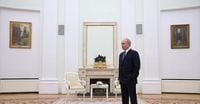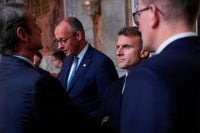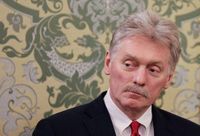At a high-stakes summit in Copenhagen on October 1, 2025, European Union leaders weighed a bold new proposal: using hundreds of billions of euros in frozen Russian assets as collateral for a massive loan to Ukraine, aimed at funding the war-torn country’s reconstruction and defense. The plan, dubbed the “Reparations Loan,” reflects the EU’s growing determination to support Kyiv even as U.S. aid has dried up and Ukraine’s needs for the coming years remain staggering.
European Commission President Ursula von der Leyen first outlined the Reparations Loan in mid-September. The scheme would leverage Russian funds—currently immobilized in European banks—to back a loan to Ukraine totaling 140 billion euros (about $165 billion). Crucially, Kyiv would only be required to repay the loan if and when Russia pays war reparations for the destruction caused by its invasion. If Moscow refuses, the assets would stay frozen, leaving the EU and its member states to cover the guarantees.
According to the Associated Press, Ukraine’s projected budget and military expenses for 2026 and 2027 are estimated at 130 billion euros ($153 billion), underscoring the scale of the challenge. Since Russia’s full-scale invasion in February 2022, the EU has already funneled 174 billion euros in aid to Ukraine. Yet, as the war grinds on, Kyiv’s financial and military needs show no sign of abating.
The frozen Russian assets represent the largest untapped resource for further support. As of June 2025, around 194 billion euros of these funds are held in Belgium alone, with additional sums in Japan, the U.S., U.K., and Canada. In total, about $300 billion in Russian assets are immobilized worldwide, including 210 billion euros ($247 billion) in Europe—most of it (185 billion euros, or $217 billion) at Euroclear, a central securities depository in Brussels.
At the Copenhagen summit, support for the Reparations Loan gathered momentum. Finnish Prime Minister Petteri Orpo, Swedish Prime Minister Ulf Kristersson, and Estonian Prime Minister Kristen Michal all publicly endorsed the idea of using seized Russian funds to back Ukraine. Danish Prime Minister Mette Frederiksen, who hosted the meeting, described the commission’s plan as “actually quite a good way forward.” She acknowledged lingering legal questions but expressed confidence that a solution could be found. “But the whole idea of using the frozen assets I think is a good idea,” Frederiksen said, as reported by Reuters and the Associated Press.
French President Emmanuel Macron and Dutch Prime Minister Dick Schoof also signaled cautious openness to the plan, provided that legal and financial risks are addressed. Macron, in particular, stressed the importance of upholding international law and maintaining Europe’s reputation as a trustworthy financial center. “We need to remain a place that’s attractive and reliable, we Europeans,” Macron said. “That means that when assets are frozen, we respect international law.”
Not all EU leaders are fully on board, however. According to both Reuters and the Associated Press, Belgium has expressed concerns about becoming a target for Russian retaliation and is reluctant to move forward without clear support from other EU countries. The European Central Bank has also warned that outright seizure of Russian assets could undermine the credibility of the euro and Europe’s financial system. Hungary, which has routinely vetoed EU support for Ukraine, remains a potential obstacle to including the loan in the EU’s next long-term budget, which would otherwise be the preferred guarantee mechanism. If that avenue closes, national guarantees might be required—a prospect that makes France, already mired in debt, uneasy.
EU foreign policy chief Kaja Kallas acknowledged the divisions within the bloc. “It’s not supported by everybody yet, so there’s still a lot of work to do,” she told reporters on the sidelines of the summit. “But if we don’t take those assets into account then it’s on our taxpayers, that’s for sure.”
While the Reparations Loan remains under discussion, interest earned on the frozen Russian assets is already being used to fund a separate loan program for Ukraine, organized by the Group of Seven (G7) major world powers. This existing arrangement would not be affected by the new EU proposal, according to both Reuters and the Associated Press.
The Kremlin, unsurprisingly, has denounced the entire scheme. “We are talking about plans for the illegal seizure of Russian property. In Russian, we call that simply theft,” Kremlin spokesman Dmitry Peskov told reporters on Wednesday. He warned that anyone misappropriating Russia’s assets or the income they generate “will be prosecuted in one way or another” and “called to account.” Peskov also claimed such actions would erode global confidence in Europe’s financial institutions, asserting, “The boomerang will very seriously hit those who are the main depositories, countries that are interested in investment attractiveness.”
European leaders have sought to draw a distinction between seizing the assets themselves—a move fraught with legal and reputational risks—and using them as collateral for a loan, which they argue is both legally sound and morally justified. Von der Leyen emphasized, “We are not confiscating the assets, but we are taking the cash balances for a loan to Ukraine. Ukraine has to pay back this loan if Russia pays reparations. Russia is the perpetrator. It has caused the damage, and it has to be held accountable.” She expressed confidence that her team had found “a sound legal way to do this” and to win over hesitant member countries.
Some EU leaders have gone further in their calls for action. German Chancellor Friedrich Merz argued last week that it was time “to apply an effective lever that will disrupt the Russian president’s cynical game of buying time and bring him to the negotiating table,” as quoted in The Financial Times. Merz stressed that the loan “would secure Ukraine’s defense capabilities for several years” and insisted that the funds should be used for military support, not economic aid.
For Finland and Sweden, the stakes are not only about supporting Ukraine but also about Europe’s broader security. “Investing in Ukraine is an investment in European security as a whole,” the two countries wrote to their EU counterparts ahead of the summit. “It is key that the loan to Ukraine is only to be repaid once Ukraine receives war reparations from Russia.”
The scale of the challenge facing Ukraine is daunting. A World Bank study released in December 2024 estimated that the country’s reconstruction will cost $524 billion over the next decade—about 2.8 times its gross domestic product for that year. With the EU now considering leveraging Russia’s own resources to help meet those needs, the debate over the Reparations Loan is likely to intensify in the weeks ahead.
As legal, political, and economic hurdles remain, the proposal’s fate is far from settled. But one thing is clear: Europe is searching for new ways to support Ukraine and hold Russia accountable, even as the war drags on and the international landscape shifts. The coming months will reveal whether the EU’s ambitious plan can bridge internal divisions and withstand external challenges—or whether the burden will ultimately fall, once again, on European taxpayers.


